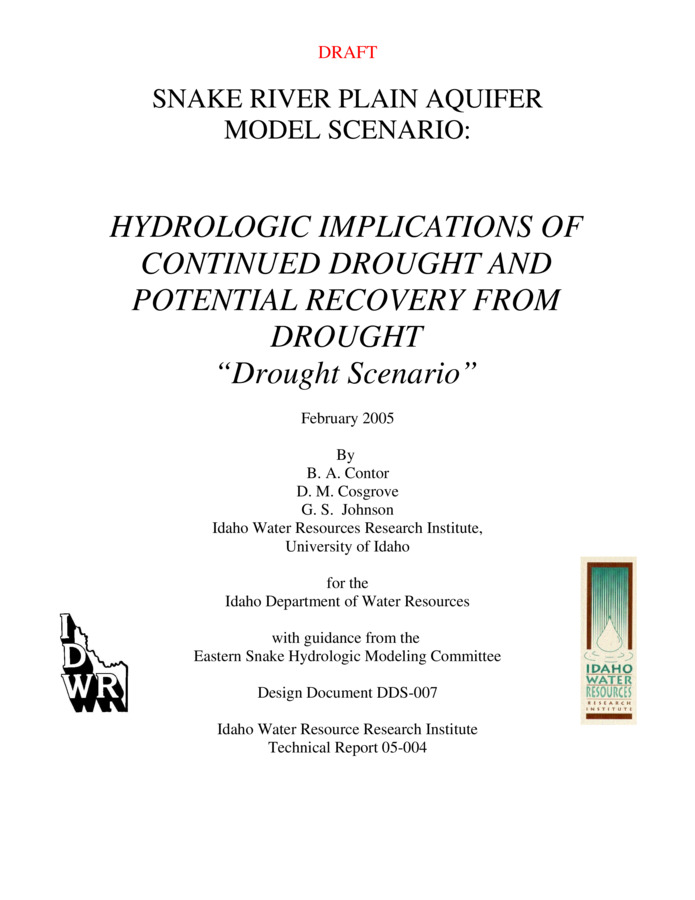PDF
Snake River Plain Aquifer Model scenario: Hydrologic implications of continued drought and potential recovery form drought ''drought scenario''. Technical report 05-004. Design document DDS-007 Item Info
- Title:
- Snake River Plain Aquifer Model scenario: Hydrologic implications of continued drought and potential recovery form drought ''drought scenario''. Technical report 05-004. Design document DDS-007
- Authors:
- Contor, B. A.; Cosgrove, D. M.; Johnson, G. S.
- Date:
- 2005-02-14
- Description:
- This scenario, Hydrologic Implications of Continued Drought and Potential Recovery from Drought, (also known as the "Drought Scenario") is one of many simulations using the Snake River Plain aquifer model to provide information and assist in resolution of conflicts among water right holders and guide future water management such as implementation of managed recharge. The purpose of the Drought Scenario is to provide context for the other scenarios, which largely examine anthropogenic stresses to the aquifer, Snake River and springs. All the scenarios use the revised Snake River Plain aquifer model to predict hydrologic response to various hypothesized aquifer stresses. The present version of the Snake River Plain aquifer model was developed with funding provided by the State of Idaho, Idaho Power Company, the U.S. Geological Survey, and the U.S. Bureau of Reclamation. The model was designed with the intent of evaluating the effects of land and water use on the exchange of water between the Snake River Plain aquifer and the Snake River. This evaluation is part of the application of the model towards this purpose. The model was developed by the Idaho Water Resources Research Institute (IWRRI) under the guidance, and with the participation, of the Eastern Snake Hydrologic Modeling Committee (ESHMC). The effort was led by the Idaho Department of Water Resources (IDWR) and active participants in the Committee included Idaho Power Company, the U.S. Geological Survey, the U.S. Bureau of Reclamation, and IWRRI. The ESHMC has also served to guide and review the scenario evaluation process. Documentation of the model and related activities are available from the Idaho Department of Water Resources and the Idaho Water Resources Research Institute at the University of Idaho. This scenario, Hydrologic Implications of Continued Drought and Potential Recovery from Drought, is intended to answer the questions: "What is the expected magnitude of impacts to the Snake River and springs if the drought continues?" and "How rapid might recovery be when the drought ceases?" The modeling results predict the spatial and temporal distribution of the hydrologic impacts to springs and rivers from three different synthetic drought and recovery regimes. bDRAFTThis scenario, Hydrologic Implications of Continued Drought and Potential Recovery from Drought, (also known as the "Drought Scenario") is one of many simulations using the Snake River Plain aquifer model to provide information and assist in resolution of conflicts among water right holders and guide future water management such as implementation of managed recharge. The purpose of the Drought Scenario is to provide context for the other scenarios, which largely examine anthropogenic stresses to the aquifer, Snake River and springs. All the scenarios use the revised Snake River Plain aquifer model to predict hydrologic response to various hypothesized aquifer stresses. The present version of the Snake River Plain aquifer model was developed with funding provided by the State of Idaho, Idaho Power Company, the U.S. Geological Survey, and the U.S. Bureau of Reclamation. The model was designed with the intent of evaluating the effects of land and water use on the exchange of water between the Snake River Plain aquifer and the Snake River. This evaluation is part of the application of the model towards this purpose. The model was developed by the Idaho Water Resources Research Institute (IWRRI) under the guidance, and with the participation, of the Eastern Snake Hydrologic Modeling Committee (ESHMC). The effort was led by the Idaho Department of Water Resources (IDWR) and active participants in the Committee included Idaho Power Company, the U.S. Geological Survey, the U.S. Bureau of Reclamation, and IWRRI. The ESHMC has also served to guide and review the scenario evaluation process. Documentation of the model and related activities are available from the Idaho Department of Water Resources and the Idaho Water Resources Research Institute at the University of Idaho. This scenario, Hydrologic Implications of Continued Drought and Potential Recovery from Drought, is intended to answer the questions: "What is the expected magnitude of impacts to the Snake River and springs if the drought continues?" and "How rapid might recovery be when the drought ceases?" The modeling results predict the spatial and temporal distribution of the hydrologic impacts to springs and rivers from three different synthetic drought and recovery regimes. DRAFT.
- Subjects:
- aquifers computer models drought
- Location:
- Eastern Snake Plain Aquifer; Southern Idaho
- Idaho County:
- Elmore County
- Latitude:
- 42.96
- Longitude:
- -115.13
- Collection:
- Boise Basin
- Series:
- ESPAM
- Source:
- Idaho Water Resources Research Institute; University of Idaho
- Publisher:
- Idaho Water Resources Research Institute; University of Idaho
- Contributing Institution:
- University of Idaho
- Type:
- Text
- Format:
- application/pdf
- Cataloger:
- KIT
- Language:
- eng
Source
- Preferred Citation:
- "Snake River Plain Aquifer Model scenario: Hydrologic implications of continued drought and potential recovery form drought ''drought scenario''. Technical report 05-004. Design document DDS-007", Idaho Waters Digital Library, University of Idaho Library Digital Collections, https://www.lib.uidaho.edu/digital/iwdl/items/iwdl-drought_14_feb_05.html
Rights
- Rights:
- In copyright, educational use permitted. Educational use includes non-commercial reproduction of text and images in materials for teaching and research purposes. For other contexts beyond fair use, including digital reproduction, please contact the University of Idaho Library Special Collections and Archives Department at libspec@uidaho.edu. The University of Idaho Library is not liable for any violations of the law by users.
- Standardized Rights:
- http://rightsstatements.org/vocab/InC-EDU/1.0/

